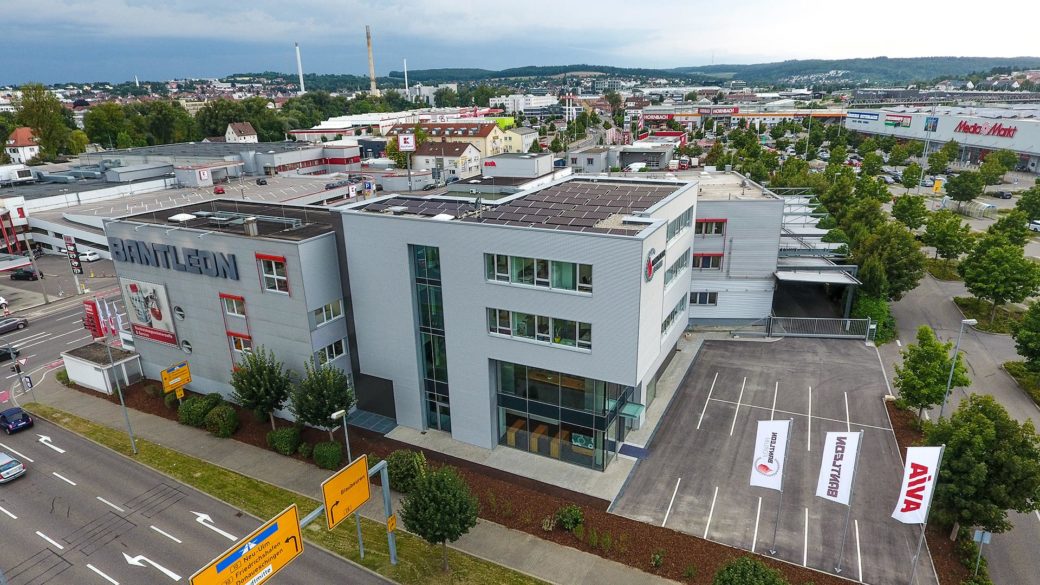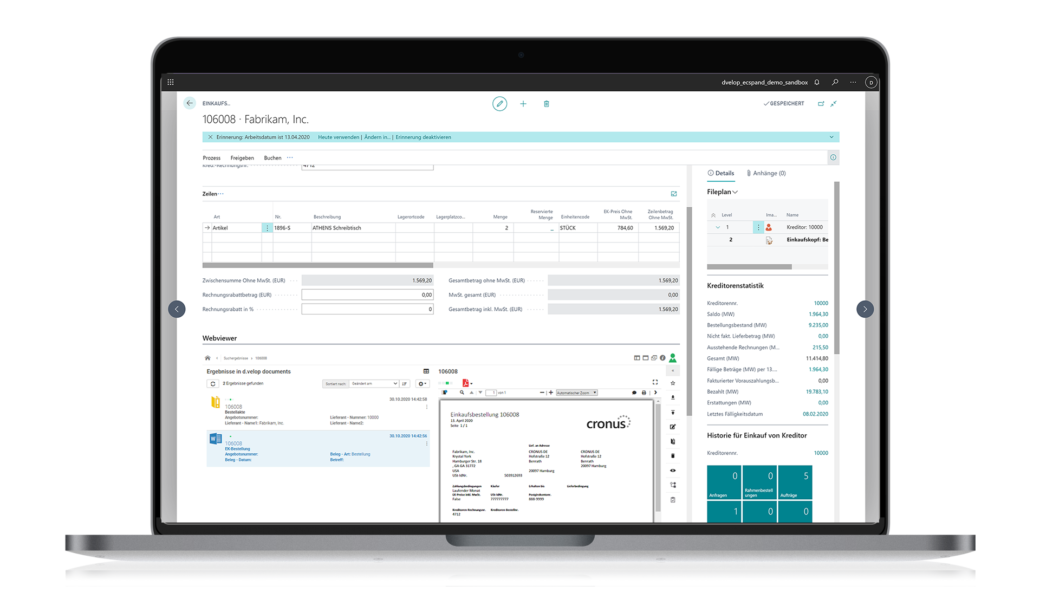Implementation of a DMS with seamless integration into the existing ERP system

Hermann Bantleon GmbH, based in Ulm, specialises in high-performance lubricants and service solutions for the metalworking industry. In addition, the company is actively involved in the development of customised lubricants, tailored to meet the specific requirements of individual material processing applications as precisely as possible. Founded in 1918, Bantleon employs approximately 265 staff members across three production sites located in Ulm, Ulm-North, and Crimmitschau. The company maintains partnerships with businesses in 40 countries worldwide.
Low Acceptance of the Old DMS
Bantleon manages around three million documents. The vast majority of these – approximately 2.8 million invoices, credit notes, and delivery slips – were generated by the company’s own ERP system. “The remainder mainly consists of documents that were manually stored at some point, such as product-specific Bantleon documents and laboratory reports,” explains Alexander Bunk, Head of IT at Bantleon. Today, employees can search for and locate these documents quickly and accurately within the system – thanks to a new document management system (DMS).
“Our old DMS solution was technically outdated. Modern interfaces, like those we’re used to from today’s web applications, were simply not there,” says Alexander Bunk, highlighting some of the issues. The end users were dissatisfied. The system was overly complex and unintuitive. “Documents weren’t easy to find. All of this led to low acceptance within the company,” the IT expert continues. This impression was confirmed by a company-wide staff survey. While the system had fulfilled its basic purpose, it had not integrated seamlessly into the IT environment. It became clear: a new system was needed.
Ideally, one should begin by identifying sub-projects or isolated solutions where a new system can be introduced step by step, without resorting to a big bang approach.
Alexander Bunk
Head of IT
Bantleon

Optimal Integration into the Bantleon System Landscape
Alexander Bunk, Head of IT at Bantleon, outlines the requirements for a new document management system (DMS) as follows: “We strategically rely on many Microsoft products. Equally important to us was integration with our ERP system, accessible simply via a web browser – without the need to install any additional client software. This allows all employees to work conveniently and as usual, without VPN tunnels or unstable remote desktop connections.”
Strong Microsoft Integration Was the Deciding Factor
d.velop offered the ideal integration into Bantleon’s system landscape with its Microsoft-compatible solutions.
The Microsoft 365 cloud suite and SharePoint also play a major role at Bantleon.
“d.velop is simply excellently integrated in that regard,” explains Alexander Bunk, highlighting why d.velop ultimately prevailed.
“Another major advantage was that the d.velop team has been supporting Bantleon for many years and knows both the people and the system environment extremely well.”
As a result, coordination doesn’t take days – or even weeks.
DMS Migration Without Time Pressure: Test Environment Established
And the DMS migration? Bantleon was able to approach it without time pressure and with thorough preparation: “We initially set up a test environment alongside our current system following the initial workshop, incorporating the insights gained during that session,” explains Alexander Bunk, Head of IT. This project phase had to be conducted entirely digitally via Microsoft Teams due to the pandemic – and it worked brilliantly, he says enthusiastically. The collaboration within the project team was both professional and collegial. “We also conducted internal surveys, and their results were taken into account.”
Integration into Core Systems Prepared Within the Test Environment
In close cooperation with individual departments and d.velop, a test system was developed that reflected the updated requirements and allowed for the planned integrations into core systems to be prepared. The system structures had to be sufficiently established so that employees could navigate the system easily and classify and store documents intuitively. “All of this was carried out absolutely smoothly and effortlessly with the d.velop team.”
Low Barrier to Entry Through CRM Integration
A major “big bang” rollout was deliberately avoided. “That’s why we began by creating integrations with our CRM system, allowing users to access documents directly from the familiar interface,” says Alexander Bunk, describing a key principle. “This significantly lowers the barrier to entry.” The system is now being introduced step by step.
d.velop documents
Product
265
Employees
Lubricants
Industry
Breaking Up Old Structures and Involving Employees
The project leads at Bantleon have some valuable advice for similar initiatives. Alexander Bunk shares: “You need to think carefully about how to break up the entrenched structures created by the previous document management system.” He strongly advises against trying to replicate the old system within the new one. He also recommends: “It’s important to involve employees in the selection and requirements process through internal surveys.” This input is invaluable for setting up the new system properly from the outset.
Bantleon Values d.velop’s In-Depth Expertise
For Bantleon, one of the most important factors in IT projects is having a manufacturer with deep expertise and close collaboration with an experienced project team. These are qualities for which d.velop is already well known at Bantleon. Just as important is the fact that “the provider not only knows its own products, but also has experience with third-party systems such as the CRM into which the solution will later be integrated,” explains Alexander Bunk. “In our case, that was Microsoft Dynamics 365 Business Central. Since the d.velop experts are also familiar with that, there was no need to bring in a third party during the project – we were able to work efficiently with a core team on implementation.” This was made possible by the standardised interface to Microsoft Dynamics 365 Business Central, developed by long-standing and close development partner Konica Minolta Business Solutions Deutschland GmbH.

Webinar: Your Dynamics 365 Hand in Hand with d.velop’s document management
Discover what a modern, digital workplace looks like with Microsoft Dynamics 365 NAV / Business Central in this engaging webinar. We’ll show you how to manage documents effortlessly within your ERP system – and the benefits it can bring to your organisation.
Look forward to insightful demonstrations of the solution and practical tips you can apply directly in your business.
Cloud-Based DMS Enables Mobile Access from the CRM System
So, what are the advantages of the new DMS? “We now have excellent integration with our CRM,” explains Alexander Bunk. “Previously, our field staff had no access at all to the old DMS via the CRM system.” With the current cloud-based solution, access is now possible even while on the move. Naturally, the cloud DMS also opens up entirely new possibilities for remote work and home office setups. The outdated and confusing usability has been replaced with a modern, intuitive interface, and the seamless integration of existing web applications makes operation significantly more convenient and user-friendly.
Digitalisation Workshop with d.velop Reveals New Opportunities
Looking ahead, there’s likely more to come in terms of digitalisation at Bantleon. “The digitalisation workshop with d.velop certainly contributed a great deal,” says Alexander Bunk, offering an example: “Our lorry drivers still carry paper delivery notes that need to be signed – perhaps in future we’ll consider electronic alternatives.” While there are no concrete plans yet, the ideas are already taking shape.
Digitising Manual Processes and Reducing Staff Workload
“We’re primarily aiming to digitise manual processes,” Bunk continues. “In our discussions, it became clear that employees were repeatedly storing the same types of documents in the same locations.” The goal is to relieve staff by automating repetitive tasks. There are also plans to optimise input management: “Instead of having individual scanners at each workstation, signed delivery notes will be scanned centrally using a multifunction device, read via barcode, and automatically filed in the correct digital record within the d.velop archive.”
Implementing Sub-Projects Instead of a Big Bang
And what advice does he have for other companies looking to advance their digitalisation efforts? Alexander Bunk recommends taking time and, if necessary, running two systems in parallel for a while. “That way, the whole process becomes much more sustainable in the long run.”
Software Demo
Learn More About d.velop Software
Request your personalised live demo of the d.velop software with just a few clicks. Get a live demonstration of the software and ask your questions directly. Simply fill out the form and we will get back to you.

